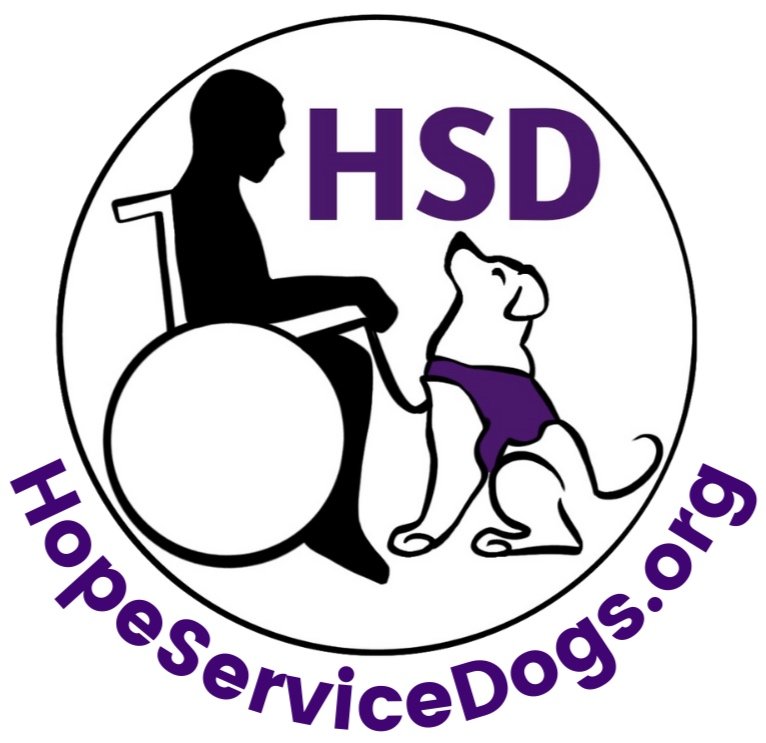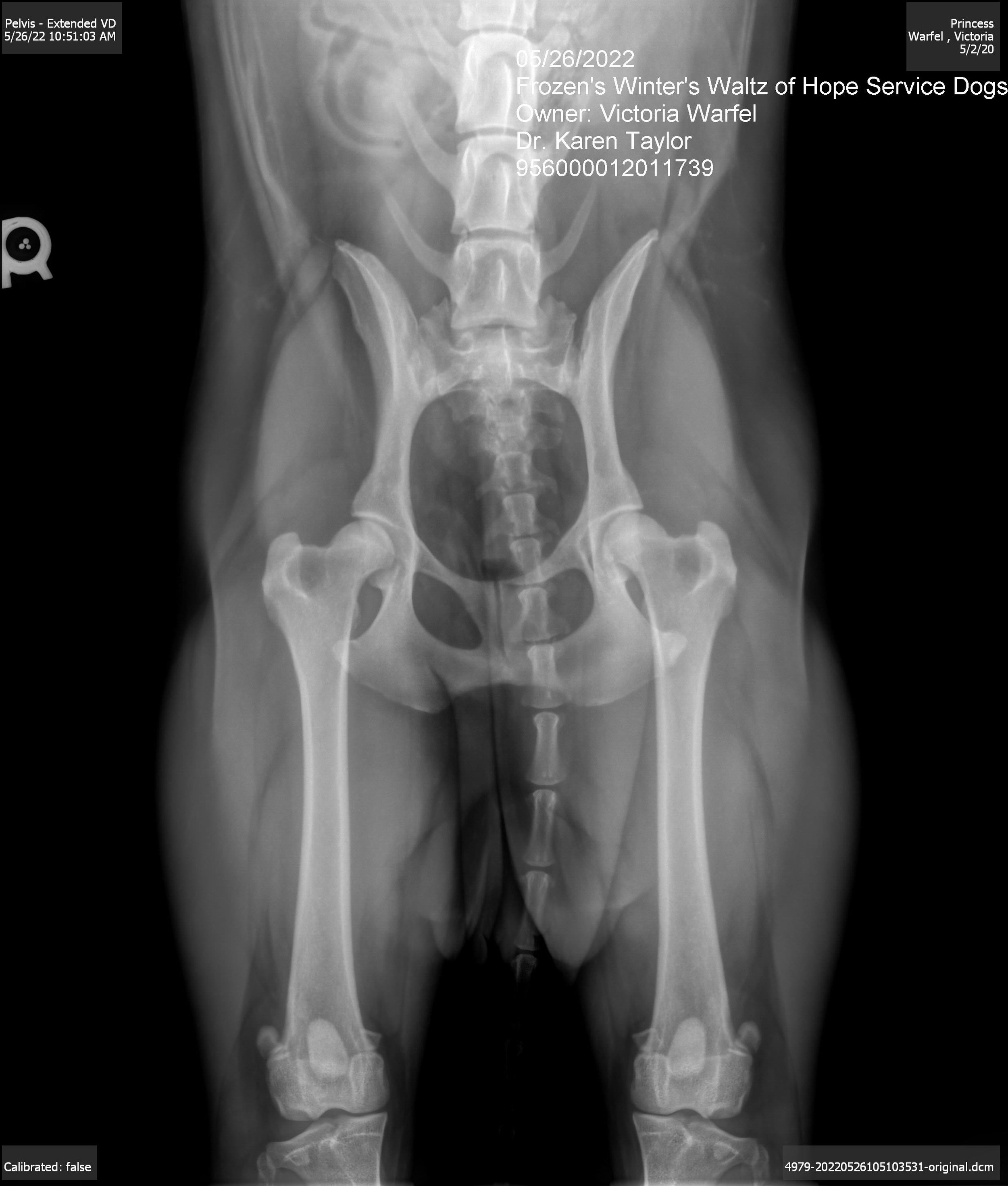Hips & Why Testing Is Important
:: Announcement ::
Princess passed her health testing and is cleared for breeding. 🥳🎉
Princess is from our Frozen litter (Seth x Lucy). This was our first litter, in 2020. We kept three girls - Princess, Diana, and Syren. Our original plan was to test their hips with PennHIP and OFA at 4 mo old, 1 year old, and 2 years old, and see if hip scores changed at the different ages.
What is PennHIP vs OFA Hips?
PennHIP
PennHIP can be tested as early as 16 weeks old. Veterinarians must be trained before they can take the series of x-rays needed for the evaluation. The dog is anesthetized so the veterinarian can manipulate hips into the correct position.
By measuring the distance the ball can be distracted from the hip socket, you get the Distraction Index (DI) number, which ranges from near zero (which indicates very tight hips) to 1.0 (which indicates very loose hips). This is an estimate of the risk for painful osteoarthritis (OA) of canine hip dysplasia (CHD) later in life.
For PennHIP, the lower the score, the better the results. Out of over 24,000 Golden Retrievers in the PennHIP database, the central 90% range is .32 to .79, and the breed average is .53.
OFA - Orthopedic Foundation for Animals
OFA data shows that out of over 170,000 Golden Retrievers tested for their hips, 19.7% show abnormal results and 77.8% show normal results.
OFA preliminary testing can be done as early as 4 months old (which is not 16 weeks old, but close). The dog does not need to be sedated, and any veterinarian can do it. This test looks at how well the joint fits in the socket and is evaluated and graded by three qualified veterinarians. The dog is assigned a rank of Excellent-Good-Fair-Borderline-Mild-Moderate-Severe.
Studies* have compared reliability of OFA preliminary results (from 4 mo old) vs final results (after the dog is 2 years old). If the dog prelims as Excellent, there is 100% reliability for a passing score (of Excellent, Good, or Fair) for their finals. If the dog prelims as Good, there is 97.9% reliability. If the dog prelims as Fair, there is 76.9% reliability. We used this information to determine that we wanted to do prelims, with a goal of Excellent or Good hips for our keepers.
The reliability increases as the dog is older.* At 3-6 months old, it is 89.6%. At 7-12 months old, it is 93.8%. At 13-18 months old, it is 95.2%. We used this information to determine that, while older is better, due to our goals, we could prelim testing as early as 4 months old.
CHD is a polygenetic trait. Which means many factors come into account. One of the changes we have made to our breeding program is that the puppies are whelped onto Avidog’s Wonder Fleece. Some breeders use quilts, towels, or even newspaper. We use fleece because it provides some traction for the little puppies. Even though they are born without the ability to see or hear, they have the instinct to find momma and nurse. And having traction and grip from those first few minutes after birth could play a part in preventing CHD.
Back to that first litter
Princess did not have her prelims done. She went into her guardian home around 3 months old, and there was not a qualified PennHIP vet near her. When she turned 2 and moved to Florida, we scheduled her health testing.
Syren and Diana were PennHip tested at 16 weeks old. Syren came back with .76/.76. Yikes. We placed her in a guardian home, who knew that her hips were lax and she would likely be washed from our breeding program. At 13 months old, Syren was retested. Her PennHIP was .71/.76 and her OFA prelim was Fair. Even though Fair is passing, this was not what we wanted for our breeding program, Syren was removed from it and given to her guardian home.
Diana was also tested at 16 weeks old. Her results came back with .66/.64. While they were better than Syren’s, they were not what we wanted for breeding.
What PennHip results are we looking for? Lower is better. Ideally, we will breed the top 40%, which is .49 and lower.
Diana would need to improve by .17 and .15 to meet that mark, a sizable difference.
According to research**, in order to improve hip joint quality and reduce CHD, both OFA and PennHip results must be used. By breeding OFA Good or Excellent, as well as hips that were at or below .30 (when the mean DI value for the entire population was .38), hip score pass rate increased from 75% to 97% in this 17 year study of over 600 dogs. This study found that using OFA hip scores alone has not reduced CHD.
Where does this leave Hope Service Dogs, Inc?
We want the best.
The goal for our breeding dogs is OFA Excellent or OFA Good, along with PennHIP .49 or lower.
Syren didn’t make it. Neither did Diana. What about Princess, the third sister?
Princess completed her final health testing and we received the results. Her OFA Hips came back as GOOD. And her PennHIP came back at .48/.49. Yippee! We have a winner - in the top 40%!
To finish out her health testing, her Elbows, Eyes, and Heart were tested and came back as Normal. Genetically, she is a PRA1 carrier, with high diversity. As we look for potential studs for when she comes into heat, we need a male that is PRA1 clear.
In 2020, we had two litters. Frozen was our first litter. Our second litter was Beauty & The Beast (Banks x Ginger). We kept one girl from that litter, Sparkles.
Sparkles was tested at 10 months old. Her PennHIP results came back .51/.50, which put her at the top 46% of all Goldens tested. Her OFA Prelim was Good. However, she was removed from our breeding program due to her under bite, which according to the veterinarian, is highly heritable. She is now working as a service dog for her owner.
These were the only 2 Golden litters where we did not use the Avidog Wonder Fleece in the whelping box. Once we learned about that product, and how it may help reduce CHD, we are sure to use that during those first formative weeks.
In 2021, we kept 2 girls from our Mermaid (Stone x Ginger) litter. Flounder and Ariel both came back with OFA prelim of Good.
That year, we also kept Sorcha from our Fantasia litter (Kale x Leta). We just got her OFA prelim results, which came back as Good. So did Artoo, a male we brought in as a potential stud and service dog.
So far this year, we kept Apple from our Snow White litter (Kale x Lucy). We will do her prelims this summer.
For our potential breeding dogs, our plan is to have OFA prelims done at 4 months old or older. If the dogs pass everything, they will be remain with our breeding program. If they do not pass, they will be released from our breeding program. At 2 years old, they will have their OFA finals and PennHIP testing to make that final determination.
We want the best.
*OFA.org website, Corley, EA, et al. Reliability of Early Radiographic Evaluation for Canine Hip Dysplasia Obtained from the Standard Ventrodorsal Radiographic Projection. JAVMA. Vol 211, No. 9, November 1997.
**Effectiveness of PennHIP and Orthopedic Foundation for Animals measurements of hip joint quality for breeding selection to reduce hip dysplasia in a population of purpose-bred detection dogs by Pamela S. Haney et al.



